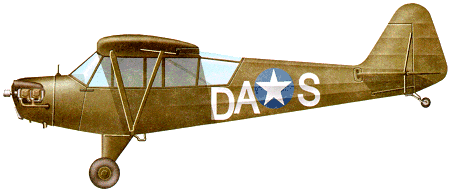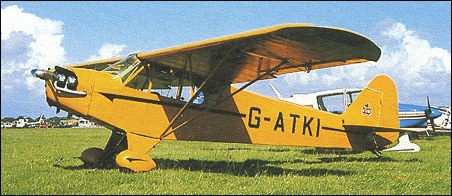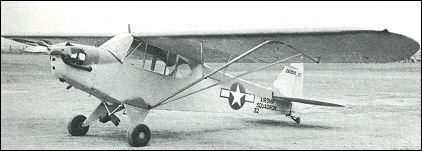|
| C. Gilbert Taylor and his brother had first established the Taylor Brothers Aviation Corporation in 1929 to market the Taylor Chummy lightplane; in 1931 the company was reorganised as the Taylor Aircraft Company, W. T. Piper Sr then being its secretary and treasurer. When the company ran into financial difficulties, manufacturing and marketing rights for the Taylor Cub, which had first flown in September 1930, were acquired by W. T. Piper who, in 1937, formed Piper Aircraft Corporation to continue production of this aircraft. A braced high-wing monoplane of mixed basic construction with fabric covering, the Cub had a conventional tail unit, fixed tailskid landing gear (the main units with wheels or optional floats) and an enclosed cabin seating two in tandem.
When first produced by Piper, the Piper J-3 Cub was powered by a 30kW Continental A40-4 flat-four engine, but it was not long before the 37kW A50-4 or alternative A50-5 with dual ignition system was introduced on the J-3C-50 Cub. The resulting improvement in performance made this already attractive lightplane an extremely marketable commodity and during 1938, which was the new company's first full year of production, no fewer than 737 Cubs were built. The Continental A50 was a new engine, early experience proving that it was reliable and had development potential, and it was later re-rated at 48kW at a higher engine speed. Its introduction by competitors meant that Piper had to follow suit, and in 1940 the J-3C-65 Cub appeared with the Continental A65 engine. With alternative Franklin flat-four engines, the 37kW 4AC-150 or 48kW 4AC-176, the Cub was designated J-3F-50 and J-3F-65 respectively and, similarly, with the Avco Lycoming 37kW O-145-A1 or 48kW O-145-B the Cub had the
respective designations J-3L-50 and J-3L-65. Also built in comparatively small numbers was a version designated J-3P-50, powered by a 37kW Lenape Papoose 3-cylinder radial engine. Sales began to soar, and then in 1941 the US Army selected this aircraft for evaluation in artillery spotting/direction roles, and shortly afterwards ordered 40 similar aircraft under the designation O-59. These aircraft.were used by the US Army under virtually operational conditions during annual manoeuvres at the end of 1941, and it was very soon discovered that the little Cub had far wider applications than at first anticipated.
This practical experience enabled the US Army to obtain an improved O-59A which, powered by a 48kW Continental O-170-3 flat-four engine, had better accommodation for the pilot and observer with an enhanced all-round view. Orders for O-59As totalled 948, but as a result of designation changes they entered service as L-4A aircraft, the earlier YO-59 and O-59 aircraft then being redesignated L-4, and the type later received the name Grasshopper. Subsequent procurements covered 980 of the L-4B version with reduced radio equipment, 1,801 of the L-4H variant with only detail changes, and 1,680 of the L-4J model which introduced a variable-pitch propeller. Civil-Cubs impressed for Army service at the beginning of World War II included eight J-3C-65s and five J-3F-65s which were designated L-4C and L-4D respectively. Piper was then requested to develop a training glider from the L-4 design and this, with powerplant removed and the forward fuselage redesigned to accommodate an instructor and two pupils, was built to a total of 250 for the US Army under the designation TG-8. Three of these gliders were acquired for evaluation by the US Navy under the designation XLNP-1 and this service also procured 230 NE-1 aircraft which, basically similar to the US Army's L-4s, were used as primary trainers; 20 similar aircraft procured at a later date were designated NE-2. When, post-war, production was switched to the further improved Cub J-4 Coupe, Piper had built a total of 14,125 civil and 5,703 military.

| MODEL | Piper J-3C-65 Cub |
| ENGINE | 1 x Continental A65 flat-four piston engine, 48kW |
| WEIGHTS |
| Take-off weight | 499 kg | 1100 lb |
| Empty weight | 290 kg | 639 lb |
| DIMENSIONS |
| Wingspan | 10.73 m | 35 ft 2 in |
| Length | 6.78 m | 22 ft 3 in |
| Height | 2.03 m | 7 ft 8 in |
| PERFORMANCE |
| Max. speed | 148 km/h | 92 mph |
| Ceiling | 3660 m | 12000 ft |
| Range | 402 km | 250 miles |
| Arnie Wheaton, e-mail, 04.09.2021 18:17 This is an outstanding publication and I thank you for it. I can get in this directory and relive my entire 45 year career in aviation. Some great memories, too!
Sent to me a fellow aviator, also retired. reply | | Burrelll Marsh Allen, e-mail, 02.08.2016 00:22 I was with the 63rd infantry division during World War II in southern France in southern Germany. I had 118 combat missions adjusting fire for a 105 howitzer battalion. The military numbers side of the plane was C – 13. This is really a beautiful aircraft to fly because it was so forgiving
After the war, I spent many hours flying Courier service with it all over southern Germany and Into Austria.On longer range missions. I would fly a German plane, a Bucher, 181. This was also a lovely airplane to fly. reply | | Frank Samples, e-mail, 05.08.2015 07:22 A lady instructor for Glenn Clark's flying school in Charleston, WV had a favorite J-3 (NC31416) which naturally got the nickname Pi. She taught many students in Pi in the early 1940's. Forty years later as a school teacher in Alaska she saw Pi on floats. The logs had entries from the time she'd flown it and belonged to a trapper. A short time later Pi broke its moorings and was lost at sea. A wonderful and true story. reply | | C.D.Cox, e-mail, 07.05.2015 01:39 In 1948 I was doing aerobatics in the Arvin,Ca area after doing some spins and inverted flight the engine quit the only place I could see to make a dead stick landing was a hayfield with about six inches of water. I turned into the wind made my approach just before touch down I pulled the stick full back put the tail skid into the water to slow down then stick full forward. Some farmers helped me pull the plan out onto a dirt road. I got the engine started made the run up checked both L&R and main mags and took off. reply | |
| | Gordon H Terwillegar, P.E., e-mail, 22.02.2014 07:32 I soloed in a J-3 in 1956 and developed a lifelong passion to own one. reply | | Don Smith, e-mail, 09.06.2013 16:28 I also learned (?) to fly in N2099M at the old Brunswick, GA airpark. At that time 99M was on Tricycle gear with the tail wheel still attached. It could be landed either way and with the stick back, would settle onto the tail wheel. I did my solo cross country to Hollywood, FL where the gas tank sprung a leak and had to be repaired before I could get home. Many other sailors got their start in this machine. This was a club plane owned by an individual who charged six dollars (wet) for it. I took care of the billing and got my time for four dollars. This was in 1960. Some big changes since then. reply | | Tom Sullivan, e-mail, 12.04.2013 17:59 I just have a comment for Ed Carney...I own N98781, about 100 off of your N#. I have the same feelings that you expressed! reply | | mr.Jordan grandson of B.Kilmer, e-mail, 07.02.2013 02:22 I am trying to aquire a j4 Cub from an elderly man in Pensilvania.despite the fact he has lost all the books on the plane.
This is an a dream to rebuild then get the rest of my hours to fly my solo and have invested in my own plane rather some one else's.
Any advice would be appriviated.
I'm not well off yet feel capable to rebuild and feel it wise to invest in my future of flying.
Owning a Piper trainer in my opinion would open doors to possibly babe a career.
Tell me what I need to know.
Sincerely, another dreamer of flight. reply | | mr.Jordan grandson of B.Kilmer, e-mail, 07.02.2013 02:21 I am trying to aquire a j4 Cub from an elderly man in Pensilvania.despite the fact he has lost all the books on the plane.
This is an a dream to rebuild then get the rest of my hours to fly my solo and have invested in my own plane rather some one else's.
Any advice would be appriviated.
I'm not well off yet feel capable to rebuild and feel it wise to invest in my future of flying.
Owning a Piper trainer in my opinion would open doors to possibly babe a career.
Tell me what I need to know.
Sincerely, another dreamer of flight. reply | | RS De Groodt, e-mail, 16.03.2012 21:12 I own Piper Cub N24739. 1939 J3. Has been down for rebuild to original specs for about two and one half years. Has a Continental 90 as it was used for crop spraying work for some time years ago. Logs show many changes and repairs over the years. Now has new wood spars, completely cleaned and sandblasted, refinished frame with epoxy paints, new fabric, even has the original small window in roof and original tapered headliner. hoping to be flying her again in April 2012. Is finished
as a US Navy Liasion aircraft used by Norfolk Naval hospital in 1942. Yellow with insignias. May be at Oshkosh this year also Lock Haven, PA. reply | | Larry Goodman, e-mail, 16.03.2012 13:51 The Taylor craft was made in Bradford PA. The airport was between big mountains. Piper then built some Cubs there, and then moved to Lock Haven, PA.
That airport is now a university. reply | | Ralph Alshouse, e-mail, 28.11.2011 03:24 I spent some time as a ferry pilot during WWII.I delivered a new FG-1 Corsair to the Marines at Fort Lauderdale FL. They had a J-3 Cub ambulance plane that needed to go to Memphis,TN for major overhaul. It had 4 cylinders for it's engine, but only three fired. That was my first mistake. Afer two refueling stops I got into the great state of Georgia. A strong head wind developed, and a southern frieght train passed me. Almost out of gas I landed in cow pasture, just missing a couple of cows. It had thick row of trees for wind break. The dairy farmer came out and gave me a ride to corner gas station and store, two miles away. Borrowed a five gallon can & funnel, paid for 5 gallons of car gas, with a government TR(transportation request) check book. The dairy farmer helped pour in the gas, and start the engine, and I left. Stayed that night at a TVA restricted airport. Flying west north west the next morning I run into a solid bank of fog. The only place to land was on a two lane highway. A sawmill foreman came along and helped me take off when the fog lifted. I made it to Memphis late afternoon. The fuel gauage on this J-3 was impressive--a cork bobber on a kinky wire. reply | | Ralph Alshouse, e-mail, 28.11.2011 03:23 I spent some time as a ferry pilot during WWII.I delivered a new FG-1 Corsair to the Marines at Fort Lauderdale FL. They had a J-3 Cub ambulance plane that needed to go to Memphis,TN for major overhaul. It had 4 cylinders for it's engine, but only three fired. That was my first mistake. Afer two refueling stops I got into the great state of Georgia. A strong head wind developed, and a southern frieght train passed me. Almost out of gas I landed in cow pasture, just missing a couple of cows. It had thick row of trees for wind break. The dairy farmer came out and gave me a ride to corner gas station and store, two miles away. Borrowed a five gallon can & funnel, paid for 5 gallons of car gas, with a government TR(transportation request) check book. The dairy farmer helped pour in the gas, and start the engine, and I left. Stayed that night at a TVA restricted airport. Flying west north west the next morning I run into a solid bank of fog. The only place to land was on a two lane highway. A sawmill foreman came along and helped me take off when the fog lifted. I made it to Memphis late afternoon. The fuel gauage on this J-3 was impressive--a cork bobber on a kinky wire. reply | | Rich Schaffer, e-mail, 17.11.2011 20:26 I soloed in the J-3 cub at Moody Aviation. Went on to be a missionary pilot for 20 years in Nigeria, West Africa accumulating a little over 10,000 hours. I have an email version of my book "Just One SIMAIR Story" that I send out free to anyone sending me their email address requesting the book. reply |
|
| | John N Pringle, e-mail, 30.09.2011 20:06 I bought a Taylor Cub, built 1937 with a 4-cylinder Continental, 2-seater, stearable tail wheel, CF-BBZ from Toronto Island A /P Charter in 1946 with spare engine for parts, spare prop and floats, $1,300. The 39.4 hp engine was under-powered, but was a good plane. Don't see it listed.JNP reply | | Rich Schaffer, e-mail, 02.08.2011 01:10 I soled in the J-3 Cub in Moody Bible Institute's Aviation Course and went on to be a missionary pilot under the Sudan Interior Mission in Nigeria, West Africa flying 10,1000 hours in my 20 years serving the Lord. I wrote a book about my exciting life and will send you the email version for free if you will send me your email address. reply |
| Rich Schaffer, e-mail, 02.08.2011 00:43 I soloed in a Piper J3 Cub in Moody Bible Institute's Aviation Course and went on to fly as a missionary pilot under the Sudan Interior Mission in Nigeria, West Africa flying 10,100 hours in my 20 years serving the Lord. I wrote a book of my exciting life and will send you the email version for free .. send me your email address to simairich@gmail.com reply | | Ken Riley, e-mail, 07.07.2011 02:07 Solo'ed in a J3 Cub in 1958 in Wichita Falls, TX, after 5 1 /2 hours and frankly never experienced a better flight. Great durable airplane considering the number of bounce landings she endured. reply | | David Kunde, e-mail, 23.03.2011 02:35 In 1954 I owned Piper J-2 N17944. I was a high school student at the time.
I spent many hours flying that airplane. I lost it in a windstorm in1956. reply | | Vern Baisden, e-mail, 01.03.2011 22:22 Soloed a J3-C65 in 1948 at 16 years of age. In that era if you wanted aomething you had to earn it. Made $13.40 a week with my bicycle after school hours as a Western Union messenger. Flying lessons were $11.75 hr. Had to pay room and board to my parents. So it took a few months of half hour lessons to solo. If you old timers remember it, the airport was Rockaway airport Queens L.I, .N. Y.
Also, the first solo is the most fun that can be had. reply |
|
Do you have any comments?
|
| 
COMPANY
PROFILE
All the World's Rotorcraft
|




 Rich Schaffer
Rich Schaffer Rich Schaffer
Rich Schaffer




Siono interessato alla versione e-mail del libro "just One SIMAIR Story,
grazie!!
reply